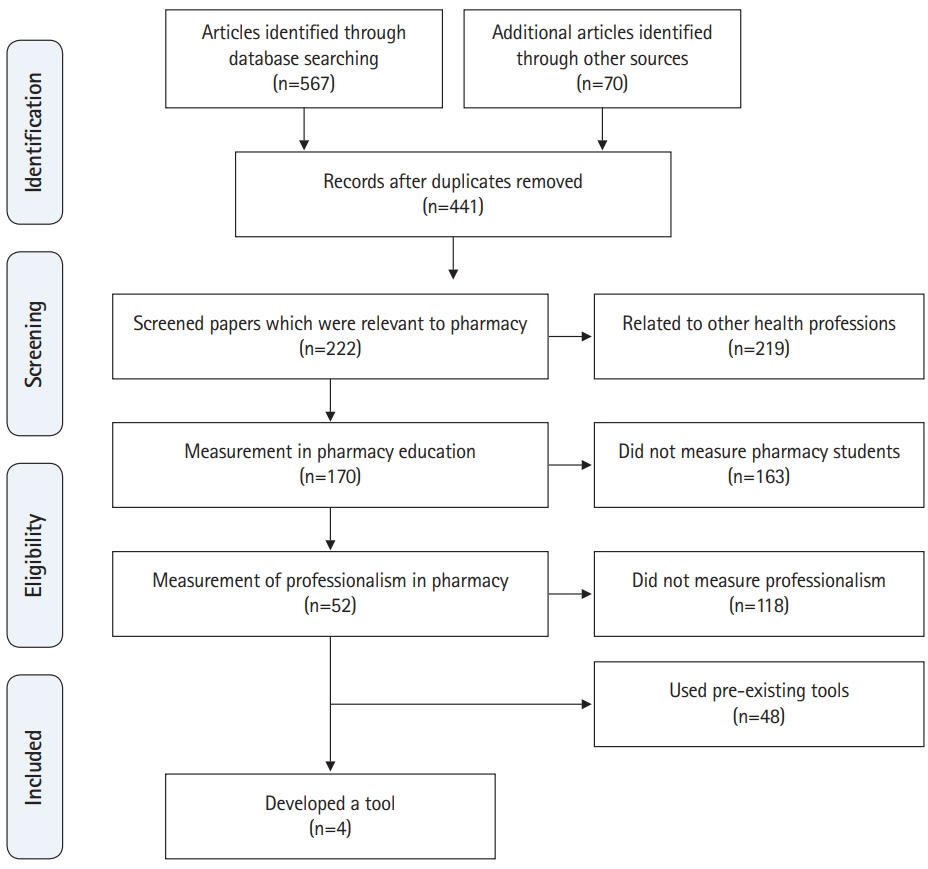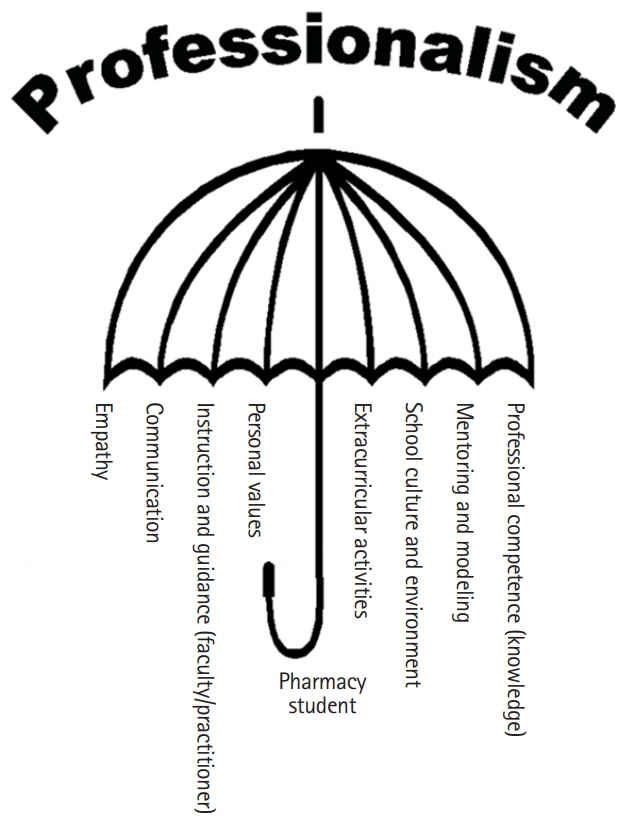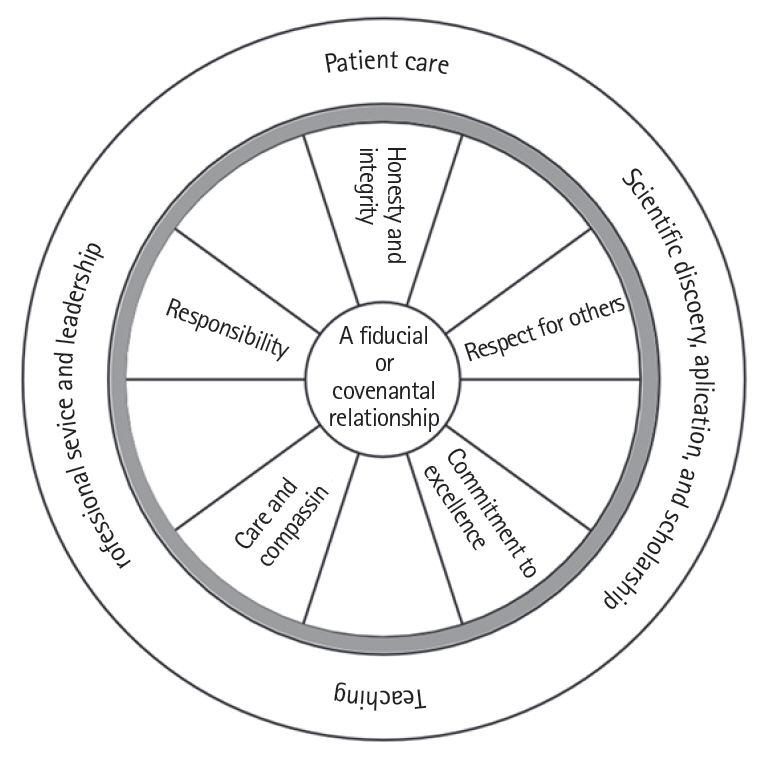J Educ Eval Health Prof.
2019;16:22. 10.3352/jeehp.2019.16.22.
Definition of professionalism and tools for assessing professionalism in pharmacy practice: a systematic review
- Affiliations
-
- 1Office of Medical Education, Faculty of Medicine, The University of New South Wales, Sydney, Australia
- 2Prince of Wales Clinical School, Faculty of Medicine, The University of New South Wales, Sydney, Australia
- 3Centre for Medical and Health Sciences Education, Faculty of Medical and Health Sciences, University of Auckland, Auckland, New Zealand
- KMID: 2502177
- DOI: http://doi.org/10.3352/jeehp.2019.16.22
Abstract
- Purpose
In contemporary pharmacy, the role of pharmacists has become more multifaceted, as they now handle a wider range of tasks and take more responsibility for providing patient care than 20 years ago. This evolution in pharmacists’ responsibilities has been accompanied by the need for pharmacists to display high-quality patient-centred care and counselling, and to demonstrate professionalism, which now needs to be taught and assessed as part of pharmacy education and practice. This study aimed at identifying definitions of professionalism in pharmacy practice and critically evaluating published instruments for assessing professionalism in pharmacy practice.
Methods
We searched the medical literature listed in Scopus, MEDLINE, and PsycINFO databases from 1 January 2000 to 31 December 2018. All papers meeting our selection criteria were reviewed and summarised into a clear review of professionalism requirements in pharmacy practice. Details of the instruments measuring professionalism were reviewed in detail.
Results
There is no accepted simple definition of professionalism, although we identified several theoretical and policy frameworks required for professional pharmaceutical practice. We identified 4 instruments (the Behavioural Professionalism Assessment Instrument, Lerkiatbundit’s instrument, the Pharmacy Professionalism Instrument, and the Professionalism Assessment Tool that build on these frameworks and measure professional practice in pharmacy students. These were found to be reliable and valid, but had only been used and tested in student populations.
Conclusion
Given the increasingly broad role of community pharmacists, there is a need for assessments of professionalism in practice. Professionalism is a complex concept that is challenging to measure because it has no standardised definition and the existing literature related to the topic is limited. Currently available instruments focus on measuring the development of the elements of professionalism among pharmacy students, rather than pharmacists.
Keyword
Figure
Reference
-
References
1. Mossialos E, Courtin E, Naci H, Benrimoj S, Bouvy M, Farris K, Noyce P, Sketris I. From “retailers” to health care providers: transforming the role of community pharmacists in chronic disease management. Health Policy. 2015; 119:628–639. https://doi.org/10.1016/j.healthpol.2015.02.007.
Article2. Ayele AA, Mekuria AB, Tegegn HG, Gebresillassie BM, Mekonnen AB, Erku DA. Management of minor ailments in a community pharmacy setting: findings from simulated visits and qualitative study in Gondar town, Ethiopia. PLoS One. 2018; 13:e0190583. https://doi.org/10.1371/journal.pone.0190583.
Article3. Torrance J. What is holding pharmacists back? Can Pharm J (Ott). 2014; 147:278–280. https://doi.org/10.1177/1715163514544632.
Article4. Jin HK, Choi JH, Kang JE, Rhie SJ. The effect of communication skills training on patient-pharmacist communication in pharmacy education: a meta-analysis. Adv Health Sci Educ Theory Pract. 2018; 23:633–652. https://doi.org/10.1007/s10459-017-9791-0.
Article5. Moullin JC, Sabater-Hernandez D, Fernandez-Llimos F, Benrimoj SI. Defining professional pharmacy services in community pharmacy. Res Social Adm Pharm. 2013; 9:989–995. https://doi.org/10.1016/j.sapharm.2013.02.005.
Article6. Mak VS, Clark A, March G, Gilbert AL. The Australian pharmacist workforce: employment status, practice profile and job satisfaction. Aust Health Rev. 2013; 37:127–130. https://doi.org/10.1071/AH12180.
Article7. Wilson S, Tordoff A, Beckett G. Pharmacy professionalism: a systematic analysis of contemporary literature (1998-2009). Pharm Educ. 2010; 10:27–31.8. Shamseer L, Moher D, Clarke M, Ghersi D, Liberati A, Petticrew M, Shekelle P, Stewart LA; PRISMA-P Group. Preferred reporting items for systematic review and meta-analysis protocols (PRISMA-P) 2015: elaboration and explanation. BMJ. 2015; 350:g7647. https://doi.org/10.1136/bmj.g7647.
Article9. McGaghie WC. Varieties of integrative scholarship: why rules of evidence, criteria, and standards matter. Acad Med. 2015; 90:294–302. https://doi.org/10.1097/ACM.0000000000000585.
Article10. Tabachnick BG, Fidell LS. Using multivariate statistics. 4th ed. Boston (MA): Allyn & Bacon;2001.11. Hammer DP. Professional attitudes and behaviors: the “A’s and B’s” of professionalism. Am J Pharm Educ. 2000; 64:455–464. https://doi.org/10.1.1.533.2723.
Article12. Thurston MM, Augustine J, Lea Bonner C. A comparison of baseline professional attitudes and behaviors among student pharmacists to inform a co-curricular professional engagement program. Curr Pharm Teach Learn. 2018; 10:875–885. https://doi.org/10.1016/j.cptl.2018.04.007.
Article13. Hammer DP, Berger BA, Beardsley RS, Easton MR. Student professionalism. Am J Pharm Educ. 2003; 67:96. https://doi.org/10.5688/aj670396.
Article14. Mylrea MF, Gupta TS, Glass BD. Professionalization in pharmacy education as a matter of identity. Am J Pharm Educ. 2015; 79:142. https://doi.org/10.5688/ajpe799142.
Article15. Rutter PM, Duncan G. Can professionalism be measured?: evidence from the pharmacy literature. Pharm Pract (Granada). 2010; 8:18–28. https://doi.org/10.4321/s1886-36552010000100002.
Article16. Hammer DP, Mason HL, Chalmers RK, Popovich NG, Rupp MT. Development and testing of an instrument to assess behavioral professionalism of pharmacy students. Am J Pharm Educ. 2000; 64:141–151.17. Hammer D. Improving student professionalism during experiential learning. Am J Pharm Educ. 2006; 70:59. https://doi.org/10.5688/aj700359.
Article18. Popovich NG, Hammer DP, Hansen DJ, Spies AR, Whalen KP, Beardsley RS, Bell HS, Athay JL. Report of the AACP professionalism task force, May 2011. Am J Pharm Educ. 2011; 75:S4. https://doi.org/10.5688/ajpe7510S4.
Article19. Holt SL, Lau MS, Wong FL, Attridge RT, Ho M, Morris JL, Rutledge ED, Sapko MM, Tu X, Vlasimsky TB. Tenets of professionalism for pharmacy students. Pharmacotherapy. 2009; 29:757–759. https://doi.org/10.1592/phco.29.6.757.
Article20. Blackall GF, Melnick SA, Shoop GH, George J, Lerner SM, Wilson PK, Pees RC, Kreher M. Professionalism in medical education: the development and validation of a survey instrument to assess attitudes toward professionalism. Med Teach. 2007; 29:e58–e62. https://doi.org/10.1080/01421590601044984.
Article21. Chalmers RK. Contemporary issues: professionalism in pharmacy. Tomorrow Pharm. 1997; 10–12.22. International Pharmaceutical Federation (FIP). Quality assurance of pharmacy education: the FIP global framework. 2nd ed. The Hagues: The International Pharmaceutical Federation (FIP);2014.23. Beardsley RS. Chair report of the APhA-ASP/AACP-COD Task Force on Professionalization: enhancing professionalism in pharmacy education and practice. Am J Pharm Educ. 1996; 60:26S.24. Wilkinson TJ, Wade WB, Knock LD. A blueprint to assess professionalism: results of a systematic review. Acad Med. 2009; 84:551–558. https://doi.org/10.1097/ACM.0b013e31819fbaa2.
Article25. American College of Clinical Pharmacy, Roth MT, Zlatic TD. Development of student professionalism. Pharmacotherapy. 2009; 29:749–756. https://doi.org/10.1592/phco.29.6.749.
Article26. Brown D, Ferrill MJ. The taxonomy of professionalism: reframing the academic pursuit of professional development. Am J Pharm Educ. 2009; 73:68. https://doi.org/10.5688/aj730468.
Article27. Grice GR, Monson K, Pitlick J, Chereson R, Duncan W, Geslani G, Kilgore K, Patel PB, Pautler H. Developing a professionalism plan. Innov Pharm. 2013; 4:103. https://doi.org/10.24926/iip.v4i1.285.
Article28. Kelley KA, Stanke LD, Rabi SM, Kuba SE, Janke KK. Cross-validation of an instrument for measuring professionalism behaviors. Am J Pharm Educ. 2011; 75:179. https://doi.org/10.5688/ajpe759179.
Article29. Ahmadi K, Ahmad Hassali MA. Professionalism in pharmacy: a continual societal and intellectual challenge. Am J Pharm Educ. 2012; 76:72. https://doi.org/10.5688/ajpe76472.
Article30. Aguilar A, Stupans I, Scutter S, King S. Towards a definition of professionalism in Australian occupational therapy: using the Delphi technique to obtain consensus on essential values and behaviours. Aust Occup Ther J. 2013; 60:206–216. https://doi.org/10.1111/1440-1630.12017.
Article31. Horsburgh M, Lamdin R, Williamson E. Multiprofessional learning: the attitudes of medical, nursing and pharmacy students to shared learning. Med Educ. 2001; 35:876–883. https://doi.org/10.1046/j.1365-2923.2001.00959.x.
Article32. Baker DP, Amodeo AM, Krokos KJ, Slonim A, Herrera H. Assessing teamwork attitudes in healthcare: development of the TeamSTEPPS teamwork attitudes questionnaire. Qual Saf Health Care. 2010; 19:e49. https://doi.org/10.1136/qshc.2009.036129.
Article33. Adepu R, Nagavi BG. Attitudes and behaviors of practicing community pharmacists towards patient counselling. Indian J Pharm Sci. 2009; 71:285–289. https://doi.org/10.4103/0250-474X.56029.
Article34. Hrisos S, Eccles MP, Francis JJ, Dickinson HO, Kaner EF, Beyer F, Johnston M. Are there valid proxy measures of clinical behaviour?: a systematic review. Implement Sci. 2009; 4:37. https://doi.org/10.1186/1748-5908-4-37.
Article35. Berenson RA. If you can’t measure performance, can you improve it? JAMA. 2016; 315:645–646. https://doi.org/10.1001/jama.2016.0767.
Article36. Broadbent J. If you can’t measure it, how can you manage it?: management and governance in higher educational institutions. Public Money Manag. 2007; 27:193–198. https://doi.org/10.1111/j.1467-9302.2007.00579.x.
Article37. Veloski JJ, Fields SK, Boex JR, Blank LL. Measuring professionalism: a review of studies with instruments reported in the literature between 1982 and 2002. Acad Med. 2005; 80:366–370. https://doi.org/10.1097/00001888-200504000-00014.
Article38. Li H, Ding N, Zhang Y, Liu Y, Wen D. Assessing medical professionalism: a systematic review of instruments and their measurement properties. PLoS One. 2017; 12:e0177321. https://doi.org/10.1371/journal.pone.0177321.
Article39. Miklich MA, Reed BN, Mattingly TJ 2nd, Haines ST. Beliefs and behaviors of professionally engaged pharmacists. J Am Pharm Assoc (2003). 2016; 56:405–411. https://doi.org/10.1016/j.japh.2016.03.011.
Article40. Schafheutle EI, Hassell K, Ashcroft DM, Hall J, Harrison S. How do pharmacy students learn professionalism? Int J Pharm Pract. 2012; 20:118–128. https://doi.org/10.1111/j.2042-7174.2011.00166.x.
Article41. Lerkiatbundit S. Factor structure and cross-validation of a professionalism scale in pharmacy students. J Pharm Teach. 2005; 12:25–49. https://doi.org/10.1300/j060v12n02_03.
Article42. Chisholm MA, Cobb H, Duke L, McDuffie C, Kennedy WK. Development of an instrument to measure professionalism. Am J Pharm Educ. 2006; 70:85. https://doi.org/10.5688/aj700485.
Article43. Tavakol M, Dennick R. Making sense of Cronbach’s alpha. Int J Med Educ. 2011; 2:53–55. https://doi.org/10.5116/ijme.4dfb.8dfd.
Article44. Schack DW, Hepler CD. Modification of Hall’s Professionalism Scale for use with pharmacists. Am J Pharm Educ. 1979; 43:98–104.45. Burke ME, LeBlanc RG, Henneman EA. ABCDs of professional introductions: teaching nursing students the most fundamental of all communication skills. Nurse Educ. 2016; 41:115–116. https://doi.org/10.1097/NNE.0000000000000216.
Article46. Poirier TI, Gupchup GV. Assessment of pharmacy student professionalism across a curriculum. Am J Pharm Educ. 2010; 74:62. https://doi.org/10.5688/aj740462.
Article47. Duke LJ, Kennedy WK, McDuffie CH, Miller MS, Sheffield MC, Chisholm MA. Student attitudes, values, and beliefs regarding professionalism. Am J Pharm Educ. 2005; 69:104. https://doi.org/10.5688/aj6905104.
Article48. Cruess RL, Cruess SR, Steinert Y. Amending Miller’s pyramid to include professional identity formation. Acad Med. 2016; 91:180–185. https://doi.org/10.1097/ACM.0000000000000913.
Article49. Hill Jr WT; American Pharmaceutical Association; Academy of Students of Pharmacy; American Association of Colleges of Pharmacy; Council of Deans Task Force on Professionalism. White paper on pharmacy student professionalism: what we as pharmacists believe our profession to be determines what it is. J Am Pharm Assoc (1996). 2000; 40:96–102. https://doi.org/10.1016/S1086-5802(16)31043-9.
Article50. Miller GE. The assessment of clinical skills/competence/performance. Acad Med. 1990; 65(9 Suppl):S63–S67. https://doi.org/10.1097/00001888-199009000-00045.
Article51. Shulruf B, Hattie J, Dixon R. Factors affecting responses to Likert type questionnaires: introduction of the ImpExp, a new comprehensive model. Soc Psychol Educ. 2008; 11:59–78. https://doi.org/10.1007/s11218-007-9035-x.
Article
- Full Text Links
- Actions
-
Cited
- CITED
-
- Close
- Share
- Similar articles
-
- Influence of Nursing Students' Clinical Practice Learning Environment, Self-leadership, and Clinical Practice Belonging on Nursing Professionalism
- Medical Professionalism-on Social Responsibilities Viewed from Historical Perspective
- Chronic Diseases and Medical Professionalism
- New Medical Professionalism
- Mediating Effect of Cultural Competence between Cultural Empathy and Nursing Professionalism in Nursing Students




